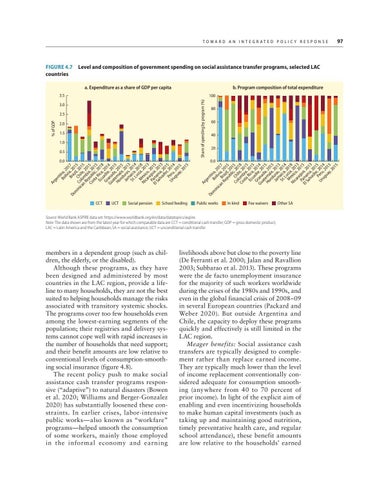T o w a r d a n I n t e g r a t e d P o l i c y R e s p o n s e
97
FIGURE 4.7 Level and composition of government spending on social assistance transfer programs, selected LAC countries a. Expenditure as a share of GDP per capita
b. Program composition of total expenditure
3.5
Share of spending by program (%)
100
3.0
% of GDP
2.5 2.0 1.5 1.0 0.5
80 60 40 20
0.0
CCT
UCT
Social pension
School feeding
nt m Bo ina, in liv 20 ica n Br ia, 2 17 Re az 01 pu il, 5 bl 201 ic Co Ch , 20 5 lo ile 18 m Co b , 2 sta ia 01 , 5 Ec Rica 201 u , 5 Gr ado 201 Gu an r, 2 4 at ada 01 Ho ema , 20 5 nd la, 15 Ja ura 201 m s, 3 St aica 201 .L , 4 M ucia 201 Ni exic , 20 8 ca o, 13 ra 2 P gu 01 El ana a, 2 5 Sa m 01 lva a, 3 do 201 P r, 5 Ur eru 201 ug , 2 4 ua 01 y, 5 20 15
ge Ar
Do
Ar
ge
nt Bo ina, liv 20 Br ia, 2 17 Do az 01 m in C Ch il, 20 5 ica ol ile 1 n R om , 2 5 e bi 01 Co pub a, 2 5 sta lic 015 , Ec Rica 201 u , 8 Gr ado 201 Gu ana r, 2 4 at da 015 Ho ema , 20 nd la, 15 Ja ura 201 m s, 3 St aica 201 .L , 4 u 20 M cia, 18 Ni exi 20 ca co 13 ra , P g 20 El ana ua, 2 15 Sa m 0 lva a, 13 do 201 P r, 5 Ur eru 201 ug , 2 4 ua 01 y, 5 20 15
0.0
Public works
In kind
Fee waivers
Other SA
Source: World Bank ASPIRE data set: https://www.worldbank.org/en/data/datatopics/aspire. Note: The data shown are from the latest year for which comparable data are CCT = conditional cash transfer; GDP = gross domestic product; LAC = Latin America and the Caribbean; SA = social assistance; UCT = unconditional cash transfer.
members in a dependent group (such as children, the elderly, or the disabled). Although these programs, as they have been designed and administered by most countries in the LAC region, provide a lifeline to many households, they are not the best suited to helping households manage the risks associated with transitory systemic shocks. The programs cover too few households even among the lowest-earning segments of the population; their registries and delivery systems cannot cope well with rapid increases in the number of households that need support; and their benefit amounts are low relative to conventional levels of consumption-smoothing social insurance (figure 4.8). The recent policy push to make social assistance cash transfer programs responsive (“adaptive”) to natural disasters (Bowen et al. 2020; Williams and Berger-Gonzalez 2020) has substantially loosened these constraints. In earlier crises, labor-intensive public works—also known as “workfare” programs—helped smooth the consumption of some workers, mainly those employed in the informal economy and earning
livelihoods above but close to the poverty line (De Ferranti et al. 2000; Jalan and Ravallion 2003; Subbarao et al. 2013). These programs were the de facto unemployment insurance for the majority of such workers worldwide during the crises of the 1980s and 1990s, and even in the global financial crisis of 2008–09 in several European countries (Packard and Weber 2020). But outside Argentina and Chile, the capacity to deploy these programs quickly and effectively is still limited in the LAC region. Meager benefits: Social assistance cash transfers are typically designed to complement rather than replace earned income. They are typically much lower than the level of income replacement conventionally considered adequate for consumption smoothing (anywhere from 40 to 70 percent of prior income). In light of the explicit aim of enabling and even incentivizing households to make human capital investments (such as taking up and maintaining good nutrition, timely preventative health care, and regular school attendance), these benefit amounts are low relative to the households’ earned

